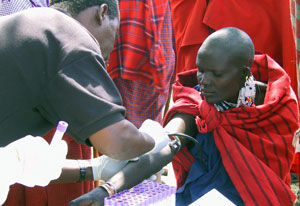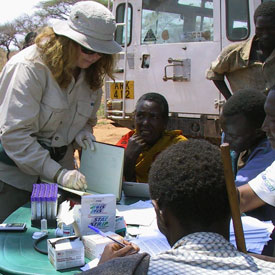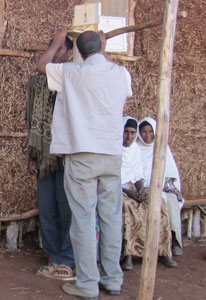Africa's genetic diversity holds promise
May / June 2013 | Volume 12, Issue 3
A richness of genomic information remains hidden in Africa, origin of anatomically modern humans 200,000 years ago, and research findings there will reveal much about diseases everywhere, according to Dr. Sarah A. Tishkoff, an expert in human evolutionary genomics. She spoke at a recent conference held by NIH's National Human Genome Research Institute to celebrate completion of the human genome mapping 10 years ago.

Photo by Dr. Sarah Tishkoff/University of Pennsylvania
Research collaborations and partnerships will help build
genomics capacity in Africa, home to the world's
broadest range of genetic diversity.
"Despite the importance of studying African genomic variation, there has been relatively little work done in the region," noted Tishkoff, of the University of Pennsylvania, whose Africa work is supported in part by NIH funding, including a prestigious Pioneer Award. "There's an urgent need to include ethnically diverse Africans in genomic studies, to identify unique, rare and common variants which may be of functional significance, including those associated with disease risk."
Africa's extensive genetic diversity is evident in Tishkoff's research. In one project, her team analyzed the genomes of just 15 individuals in three different populations and identified 13 million variants, including 3 million not previously found anywhere - expanding all known human genetic variation by 8 percent.
African populations suffer from an array of infectious diseases, such as malaria, tuberculosis and HIV/AIDS, but their disease burden is shifting toward many of the chronic diseases more common in developed countries, including hypertension, diabetes and cardiovascular disease. Tishkoff emphasized, "If we want to understand risk factors for these diseases, we need to be looking at Africa."

Photo by Dr. Simon Thompson/
University of Pennsylvania
A study on Pygmies and neighboring Bantu
populations investigated whether short stature is
adaptive to life in dense forests.
Efforts to expand African genomics capacity are on the rise, not only from independent research collaborations, but also from partnerships. The Human Heredity and Health in Africa (H3Africa) Initiative, supported by NIH and the Wellcome Trust, aims to develop African genomics expertise, establish a continent-wide bioinformatics network and create biorepositories for use in scientific investigations. Tishkoff noted, "The H3Africa project hopefully is going to have a major impact on training and capacity building to do genomics research in Africa."
In more than a decade of genomics research in Africa, Tishkoff and her collaborators have produced findings about many different African populations, especially little-studied minorities. At least 2,000 ethnic groups exist on the continent and their genes have adapted to a broad range of environments. She noted, "It's thought that mutations associated with common diseases in modern populations may have been selectively advantageous in the past."
Her team has collected more than 10,000 blood samples, conducted detailed ethnographic surveys about diet, nutrition and other environmental influences and measured phenotypic variation ranging from height to blood types to metabolic function.

Photo by Dr. Simon Thompson/
University of Pennsylvania
A study on Pygmies and neighboring
Bantu populations investigated
whether short stature is adaptive to life
in dense forests.
One study focused on the short-statured Pygmy people of western Africa, whose average height of 60 inches compares with an average 80 inches in neighboring Bantu populations. Pygmies dwell in tropical forests where shortness may be advantageous, Tishkoff suggested. The researchers found numerous genomic differences that influenced not only height, but also neuroendocrine signaling, reproduction, metabolism and immune function.
In another study, Tishkoff and her collaborators investigated why some African populations digest lactose with ease in adulthood. They found three relevant genomic variations, none of which matches the mutation that brings lactose tolerance in many people from Northern Europe. Tishkoff estimated the African adaptations evolved 3,000 to 7,000 years ago, along with cattle domestication.
Her research also looked at possible genomic adaptations tied to skin pigmentation differences within Africa, enhanced ability to taste bitterness in food and high hemoglobin levels seen in Ethiopians living at high altitude.
One area of research that needs urgent attention is pharmacogenomics. Tishkoff noted, "There can be differences in how people respond to drugs and ... we need to have better characterization of variation in Africa to develop better treatments."
"If we want to learn more about the African diaspora and African-American ancestry, we need to be looking at Africa," she concluded. "We are just at the beginning of characterizing that extent of variation, particularly across diverse populations."
More Information
To view Adobe PDF files,
download current, free accessible plug-ins from Adobe's website.